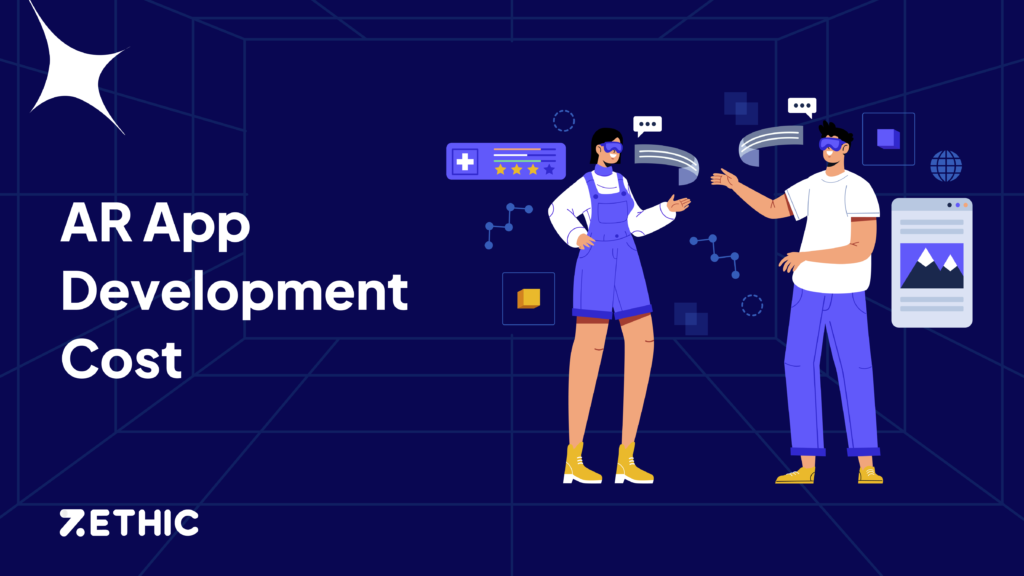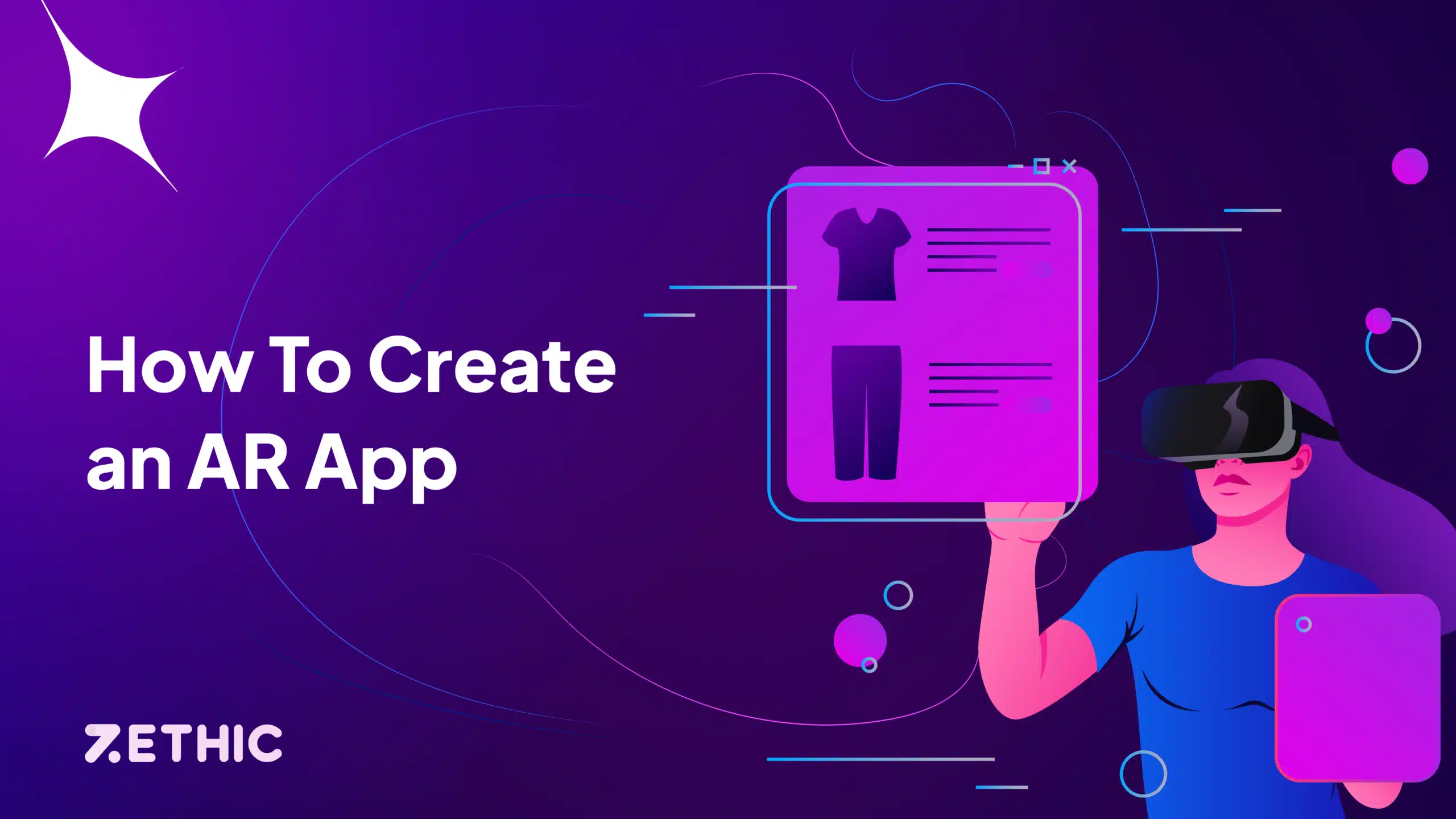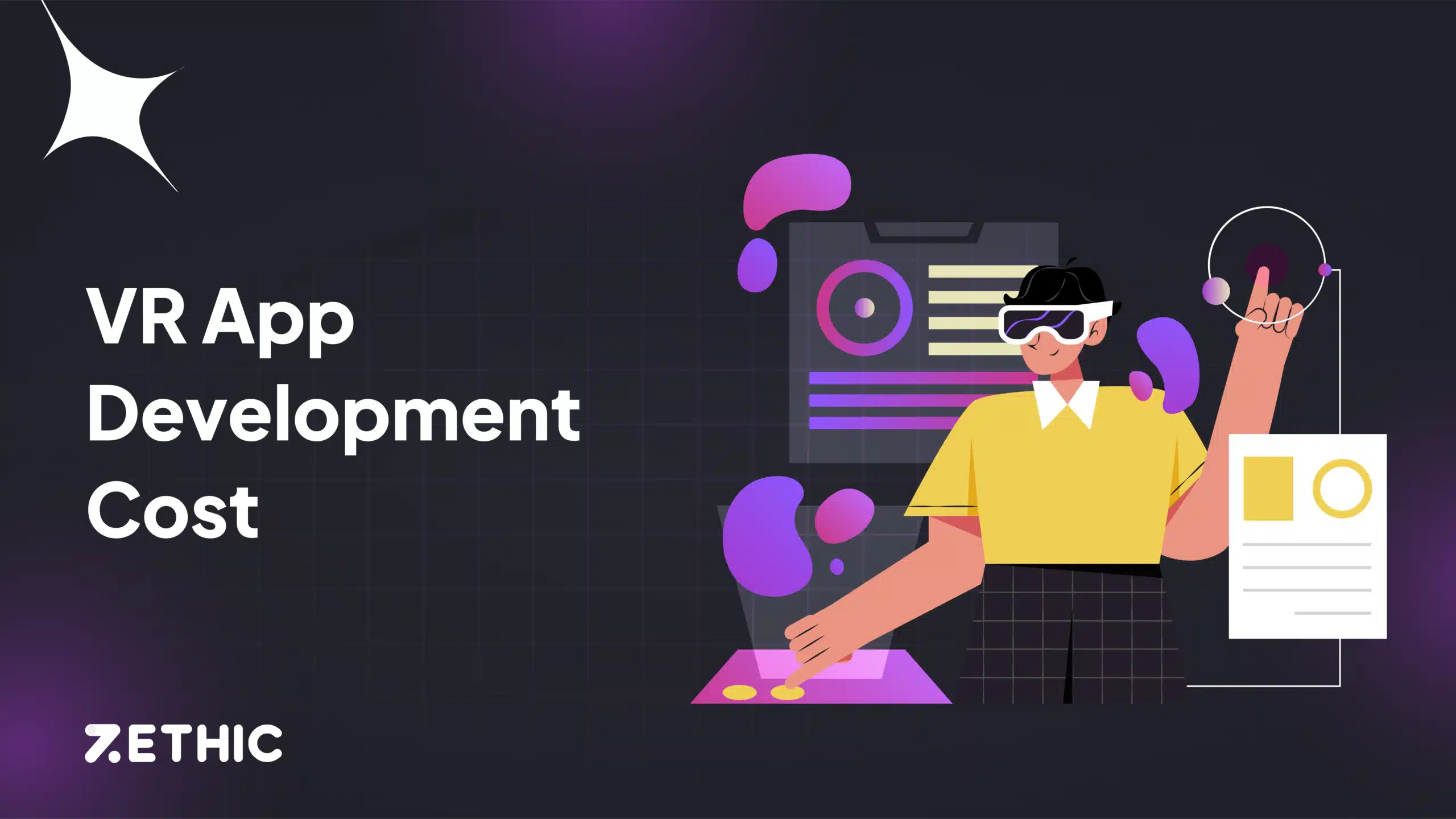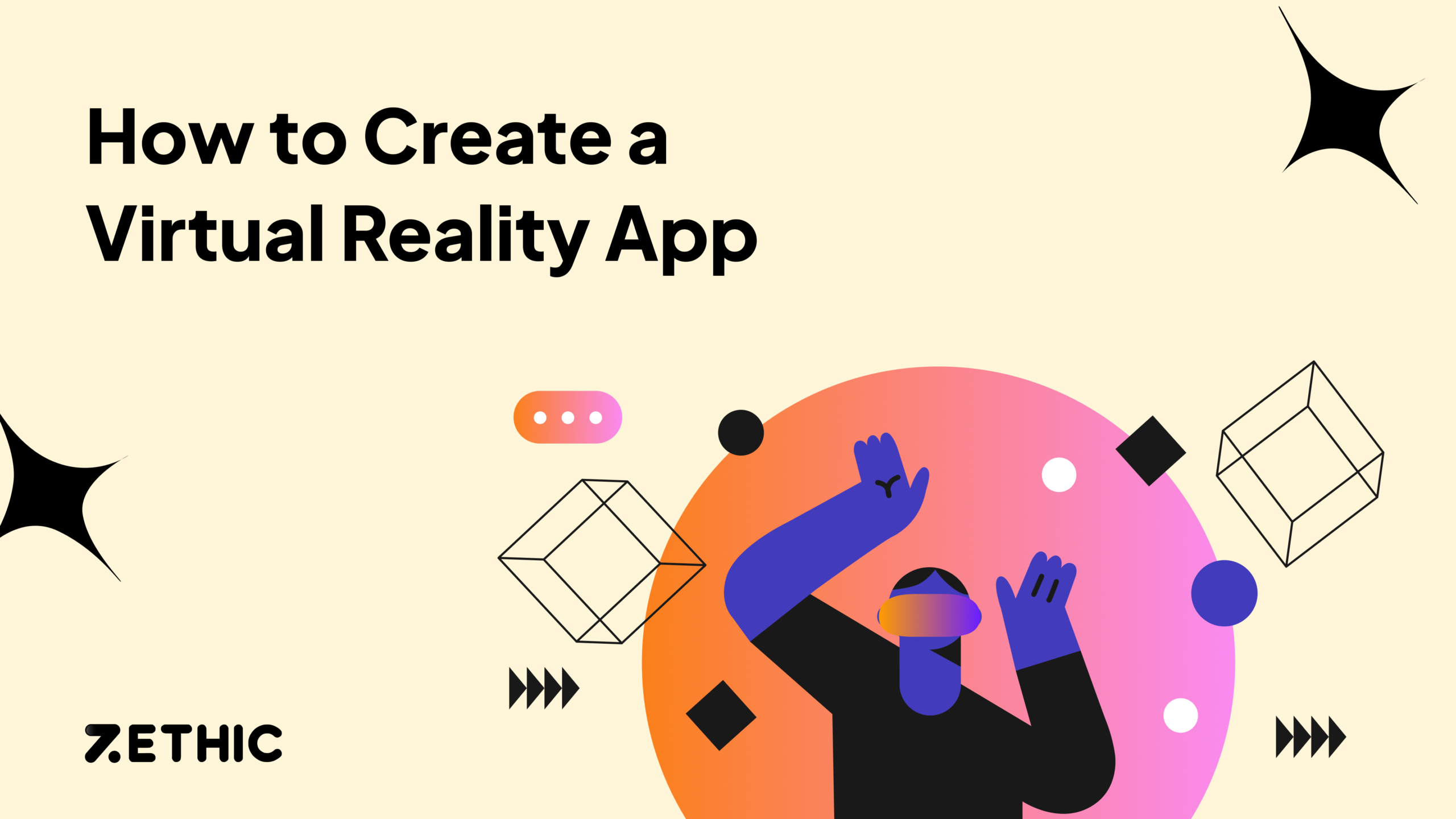Augmented Reality (AR) is a technology that overlays digital information onto the real world, enhancing our perception of reality. By seamlessly blending the virtual and physical worlds, AR offers a unique and immersive experience. This transformative technology has gained significant traction in recent years, finding applications across various industries, from gaming and entertainment to education and healthcare.
The demand for AR app development has skyrocketed as businesses and individuals recognize the immense potential of this technology. By creating innovative AR experiences, developers can captivate audiences, streamline processes, and drive engagement. This guide explores the essential steps on how to develop an augmented reality app, covering everything from conceptualization to deployment.
Table of Contents
What is AR App Development?
AR app development involves creating applications that overlay digital content onto the real world, enhancing user experiences. Unlike virtual reality (VR), which immerses users in a completely virtual environment, AR augments reality by adding digital layers to the physical world.
AR apps can be categorized into three primary types:
- Marker-based AR: This type of AR recognizes specific markers or images in the real world and overlays digital content on top of them.
- Location-based AR: Location-based AR utilizes GPS data to trigger AR experiences in specific locations.
- Projection-based AR: Projection-based AR projects interactive light patterns onto real-world surfaces, creating interactive experiences.
Benefits of AR App Development
AR app development offers a multitude of benefits that can revolutionize various industries. By leveraging the power of augmented reality, businesses can enhance user experiences, increase engagement, and boost brand loyalty.
Enhanced User Experience
- Immersive experiences: AR apps create immersive experiences that captivate users and leave a lasting impression.
- Interactive content: Interactive elements, such as 3D models, animations, and virtual objects, make content more engaging and informative.
- Personalized experiences: AR apps can be tailored to individual preferences, providing personalized experiences that resonate with users.
Increased Engagement and User Retention
- Novelty factor: AR apps introduce a novelty factor that attracts users and keeps them coming back for more.
- Gamification: Incorporating gamification elements, such as challenges and rewards, can significantly increase user engagement.
- Social sharing: AR experiences can be easily shared on social media, expanding reach and driving brand awareness.
Improved Brand Loyalty and Customer Satisfaction
- Unique brand experiences: AR apps allow brands to create unique and unforgettable experiences that differentiate them from competitors.
- Enhanced customer service: AR can be used to provide interactive customer support, improving customer satisfaction and loyalty.
- Product visualization: AR enables customers to visualize products in real-world settings, reducing return rates and increasing sales.
By harnessing the potential of AR app development, businesses can unlock new opportunities, drive innovation, and stay ahead of the curve.
Bring Your Ideas to Life with AR Apps
Create immersive AR experiences for your users. Contact us to develop your AR app today!
What Industries Use AR App Development and Augmented Reality?
AR app development has the potential to revolutionize various industries. Let’s explore some of the key sectors that are leveraging AR technology:
AR App Development in Retail and E-commerce
- Virtual Try-On: AR enables customers to virtually try on clothes, accessories, and makeup, enhancing the online shopping experience.
- Product Visualization: AR can be used to visualize products in real-world settings, helping customers make informed purchase decisions.
- Interactive Product Information: AR can provide interactive product information, such as detailed specifications and usage instructions, by overlaying digital content onto physical products.
AR App Development in Healthcare
- Medical Training: AR can be used to create realistic simulations for medical training, allowing students and professionals to practice procedures in a safe and controlled environment.
- Surgical Guidance: AR can provide real-time guidance during surgeries, improving precision and reducing surgical time.
- Patient Education: AR can be used to explain complex medical conditions and treatment plans to patients in an engaging and easy-to-understand manner.
AR App Development in Education
- Interactive Learning Experiences: AR can create interactive and immersive learning experiences, making education more engaging and effective.
- Field Trips and Virtual Tours: AR can enable students to take virtual field trips and explore historical sites and natural wonders.
- Language Learning: AR can be used to enhance language learning by providing visual and auditory cues in real-world contexts.
AR App Development in Manufacturing
- Assembly Line Guidance: AR can provide real-time assembly instructions and visual aids to workers on the assembly line, improving efficiency and accuracy.
- Remote Maintenance and Repair: AR can enable remote experts to guide technicians on-site, reducing downtime and minimizing the need for travel.
- Quality Control: AR can be used to identify defects and inconsistencies in products, improving quality control processes.
AR App Development in Real Estate
- Virtual Property Tours: AR can be used to create virtual property tours, allowing potential buyers to explore properties remotely.
- Interior Design Visualization: AR can help visualize furniture and decor in real-world spaces, aiding in interior design decisions.
- Property Marketing: AR can be used to create interactive marketing materials, such as virtual brochures and property presentations.
AR App Development in Gaming and Entertainment
- Immersive Gaming Experiences: AR can enhance gaming experiences by overlaying digital elements in the real world, blurring the lines between the virtual and physical.
- Interactive Entertainment: AR can be used to create interactive entertainment experiences, such as interactive storytelling and games.
- Theme Parks and Attractions: AR can be used to create immersive theme park experiences, adding a layer of magic and wonder.
AR App Development in Automotive
- Vehicle Design and Prototyping: AR can be used to visualize vehicle designs in 3D, accelerating the design and development process.
- Vehicle Maintenance and Repair: AR can provide step-by-step instructions and visual aids for vehicle maintenance and repair tasks.
- Enhanced Driving Experiences: AR can be used to display important information, such as navigation directions and traffic alerts, directly on the windshield.
AR App Development in Military and Defense
- Training and Simulation: AR can be used to create realistic training simulations, improving the effectiveness of military training.
- Remote Operations: AR can enable remote control of drones and other military equipment, providing a first-person perspective.
- Intelligence and Surveillance: AR can be used to analyze and interpret real-time data, aiding in intelligence gathering and surveillance operations.
As AR technology continues to advance, we can expect to see even more innovative applications across various industries. By embracing AR app development, businesses can unlock new opportunities, enhance user experiences, and drive growth.
How To Develop An Augmented Reality App
Explore the key steps in AR App Development, from planning and research to design, development, and testing. Learn how to create engaging, user-friendly AR experiences that drive business success.
Key Steps for AR App Development
1. Planning and Research
Identify Target Audience:
- Demographics: Consider age, gender, location, and socioeconomic status to shape your app’s appeal.
- Interests: Focus on user hobbies, preferences, and passions for a more engaging experience.
- Tech-Savviness: Gauge users’ understanding of AR technology and smartphone use to determine the app’s accessibility.
Define App Purpose and Goals:
- Core Functionality: Identify the main problem the app solves or the experience it enhances.
- Key Features: Determine specific features that will make the app valuable and unique.
- Monetization Strategy: Decide on revenue methods, such as in-app purchases, advertising, or subscriptions.
2. Design
User Interface (UI):
- Intuitive Design: Create a simple, user-friendly interface that’s easy to navigate.
- Visual Appeal: Use attractive graphics, animations, and color schemes to captivate users.
- Clear Information Hierarchy: Structure information logically to improve understanding and usability.
User Experience (UX):
- Immersive Experience: Craft experiences that smoothly merge virtual elements with the real world.
- Smooth Interactions: Ensure interactions are responsive, allowing users to engage naturally with AR content.
- Accessibility: Include features for users with disabilities to make the app accessible for all.
3. Development
Choosing the Right Platform:
- iOS: Offers a robust AR platform (ARKit) with advanced capabilities.
- Android: Has a broad user base and supports AR with ARCore.
- Cross-Platform Development: Use tools like Unity or Unreal Engine to create apps compatible with both iOS and Android.
Selecting AR Development Tools:
- ARKit: Apple’s framework for AR development on iOS.
- ARCore: Google’s platform for AR on Android.
- Unity: A versatile game engine widely used for AR app development.
- Unreal Engine: A powerful engine for developing complex AR experiences.
4. Testing
Importance of Beta Testing:
- Identify Bugs and Issues: Rigorous testing helps identify and fix bugs for a smooth user experience.
- Optimize Performance: Enhance the app’s performance for responsiveness and fluidity.
- Gather User Feedback: Obtain insights from beta testers to refine features and usability.
User Feedback Integration:
- Analyze Feedback: Carefully review feedback to pinpoint areas needing improvement.
- Prioritize Features: Focus on features that align with user feedback and business goals.
- Iterate and Improve: Continuously refine the design and functionality to enhance the user experience.
By following these steps and embracing the unique challenges of AR app development, you’re well on your way to creating immersive AR experiences that captivate users and drive business growth. If you’re ready to take your vision further, Zethic offers expert AR app development services to help you deliver impactful and engaging user experiences—reach out to our team today!
Unleash the Power of Augmented Reality
Transform your business with advanced AR apps. Get in touch for a free consultation!
Get A Free QuoteAR App Development Tools and Software
Key Tools and Platforms
To develop robust and engaging AR apps, developers rely on a variety of tools and platforms. Some of the most popular ones include:
- Unity: A versatile game engine that offers a wide range of features for AR development, including scripting, asset creation, and deployment.
- Unreal Engine: A powerful game engine known for its high-quality graphics and advanced features, making it suitable for complex AR experiences.
- Vuforia: A leading AR SDK that provides features like image recognition, object tracking, and spatial mapping.
- ARKit: Apple’s AR development platform for iOS devices, offering advanced features like face tracking and motion capture.
- ARCore: Google’s AR development platform for Android devices, enabling developers to create immersive AR experiences.
Programming Languages
The primary programming languages used for AR development are:
- C#: A versatile language used for Unity and Unreal Engine development.
- Swift: Apple’s programming language for iOS development, including ARKit apps.
- Java: The primary language for Android development, including ARCore apps.
Algorithms and ML Models
AR development often involves the use of various algorithms and machine learning models:
- Computer Vision Algorithms: These algorithms enable devices to understand and interpret the real world, such as object recognition, image tracking, and scene understanding.
- Machine Learning Models: ML models can be used for tasks like real-time object detection, semantic segmentation, and pose estimation.
- 3D Rendering Algorithms: These algorithms are used to render 3D objects and scenes in real time, creating immersive AR experiences.
By mastering these tools, languages, and algorithms, developers can create innovative and engaging AR apps that push the boundaries of technology.
Challenges in AR App Development
While AR app development offers immense potential, it comes with its own set of challenges:
Technical Limitations and Device Compatibility:
- Hardware Constraints: AR apps require powerful hardware to function smoothly, which can limit their accessibility on older devices.
- Software Compatibility: Ensuring compatibility with different operating systems and AR platforms can be complex.
- Sensor Accuracy: Accurate sensor data is crucial for AR experiences. Inaccurate sensor data can lead to poor performance and user frustration.
High Development Costs:
- Specialized Skills: Developing AR apps requires specialized skills, including 3D modeling, animation, and programming.
- Expensive Tools and Software: High-quality AR development tools and software can be costly.
- Time-Consuming Development Process: Creating immersive AR experiences can be time-consuming, requiring significant development effort.
Delivering Seamless User Experience:
- Motion Sickness: Poorly designed AR experiences can lead to motion sickness, reducing user enjoyment.
- Battery Drain: AR apps can be resource-intensive, leading to rapid battery drain.
- Network Connectivity: Reliable network connectivity is essential for cloud-based AR experiences.
By understanding these challenges and addressing them proactively, Zethic overcomes obstacles to help you with AR App Development that delivers seamless, enjoyable user experiences. Ready to bring your AR vision to life? Connect with Zethic today for expert solutions tailored to your needs!
How Much Does AR App Development Cost?

The AR app development cost can vary widely, ranging from $5,000–$800,000 or more, depending on the app’s complexity, features, and other factors.
Factors Influencing AR App Development Cost
- Complexity
- Simple AR App: Typically costs between $10,000–$50,000, focusing on basic AR functions.
- Medium Complexity App: Estimated at $50,000–$200,000, featuring a broader range of interactive features.
- Complex AR App: Highly interactive with advanced capabilities, ranging from $250,000–$800,000 due to increased development time and resources.
| App Complexity | Cost Range | Description |
| Simple AR App | $10,000 – $50,000 | Focuses on basic AR functions, ideal for simple, straightforward applications. |
| Medium Complexity App | $50,000 – $200,000 | Includes a broader range of interactive features, offering an enhanced user experience. |
| Complex AR App | $250,000 – $800,000 | Highly interactive, with advanced capabilities requiring extensive development time and resources. |
- Design Complexity
- 3D Model Complexity: Detailed models require more development time, impacting cost.
- Interactive Elements: Buttons, sliders, and menus add to overall expenses.
- UI/UX Design: Skilled designers enhance app quality with intuitive and engaging UI/UX.
- Platform Selection
- iOS or Android: Developing on both platforms increases costs due to separate development needs.
- Web-Based AR: Accessible across devices but may have performance limitations.
- Feature Set
- Core AR Features: Standard features like object recognition and 3D rendering.
- Advanced Features: Capabilities such as real-time object detection, facial recognition, and spatial mapping significantly increase development costs.
- Backend Integration: Adding backend connections or APIs adds complexity and expense.
Budget Planning Tips For AR App Development Cost
- Define Scope Clearly: Avoid scope creep by setting clear core features.
- Select an Expert Team: Choose a team skilled in AR, including 3D modeling, animation, and programming.
- Consider Outsourcing: Outsourcing tasks to experienced agencies can reduce costs; verify partners carefully.
- Utilize Free Tools: Tools like Unity and Unreal Engine help manage costs.
- Plan Iteratively: Incremental development allows for efficient adjustments and budget control.
- Allocate for Maintenance: Set aside a budget for ongoing updates and bug fixes.
- Thorough Testing: Dedicate resources to testing for optimal quality.

AR App Development Cost Breakdown
(Note: These costs are estimates and may vary based on specific project requirements and developer location.)
| Phase | Cost Range | Factors Affecting Cost |
| Planning and Design | $5,000 – $20,000 | Complexity of app idea, UI/UX design |
| Development | $10,000 – $100,000 | Platform choice, feature complexity, 3D models |
| Testing and Quality Assurance | $5,000 – $15,000 | Testing, bug fixing, optimization |
| Deployment and Launch | $2,000 – $5,000 | App store submission, marketing |
| Maintenance and Updates | Ongoing | Regular updates, server costs |
Total Cost Estimate: Approximately AR App Development $22,000 – $140,000
Additional Cost Considerations:
- Developer Experience and Location: Rates vary by expertise and regional labor costs.
- Complex AR Features: Advanced capabilities like real-time tracking and spatial mapping raise costs.
- Platform Selection: Multi-platform development requires additional resources.
- Third-Party Integrations: Adding third-party services or APIs increases complexity.
- Ongoing Support: Maintenance and updates are essential for long-term app success.
For a tailored estimate, it’s best to consult with a skilled AR development company or freelancer.
Looking to bring your AR app vision to life?
Contact Zethic for expert AR development solutions crafted to fit your needs and budget.
How Long Does it Take to Develop an AR App?
Time for an AR app development can vary significantly depending on several factors, including:
- Complexity of the App: A simple AR app with basic features may take a few weeks to develop, while a complex app with advanced features could take several months.
- Experience of the Development Team: An experienced team can streamline the development process and reduce development time.
- Platform Selection: Developing for multiple platforms (iOS and Android) will require additional development time.
- Iterative Development Approach: An iterative approach, where the app is developed in stages, can help accelerate the development process.
Typical Development Timeline:
| Phase | Timeframe |
| Planning and Design | 2-4 weeks |
| Development | 4-12 weeks |
| Testing and Quality Assurance | 2-4 weeks |
| Deployment and Launch | 1-2 weeks |
Total Time: 9-22 weeks (approximately)
Please note that this is a rough estimate, and the actual development time may vary.
For a more accurate estimate tailored to your project, consult with Zethic, an expert AR development company. Our team will assess your specific requirements and provide a precise timeline to bring your vision to life.
Future Trends in AR
The future of AR is brimming with exciting possibilities. As technology continues to advance, we can expect to see significant developments in the following areas:
5G Integration
- Low-Latency Experiences: 5G networks will enable faster data transfer speeds and lower latency, resulting in smoother and more responsive AR experiences.
- Cloud-Based AR: Cloud-based AR platforms will allow users to access powerful AR experiences without requiring high-end devices.
AI Integration
- Real-Time Object Recognition and Tracking: AI-powered object recognition and tracking algorithms will enable more accurate and efficient AR experiences.
- Personalized AR Experiences: AI can be used to tailor AR experiences to individual preferences and needs.
- Natural Language Processing: Voice commands and natural language processing will make AR interactions more intuitive and user-friendly.
Industry-Specific Applications
- Healthcare: AR can be used for surgical simulations, remote patient monitoring, and medical education.
- Retail: AR-powered virtual try-on experiences and product visualizations can enhance the shopping experience.
- Education: AR can create immersive learning experiences, bringing textbooks to life and making education more engaging.
- Real Estate: AR can be used to visualize property interiors and exteriors, helping potential buyers make informed decisions.
- Manufacturing: AR can be used for assembly line guidance, remote maintenance, and quality control.
As AR technology continues to evolve, we can expect to see even more innovative and impactful applications. The future of AR is bright, and it promises to reshape the way we interact with the world around us.
Conclusion
Augmented Reality (AR) has the potential to revolutionize the way we interact with the world around us. By seamlessly blending the digital and physical realms, AR offers a wide range of benefits, including enhanced user experiences, increased engagement, and improved productivity.
For businesses, AR presents a unique opportunity to differentiate themselves from competitors, create innovative marketing campaigns, and streamline operations. Developers, on the other hand, can explore a new frontier of creativity and innovation, building immersive and interactive AR experiences.
Ready to embark on your AR journey?
Zethic is your trusted AR VR app development company with our expertise and cutting-edge technology, we can help you bring your AR vision to life.
Contact us today to discuss your project and explore the possibilities of AR.





